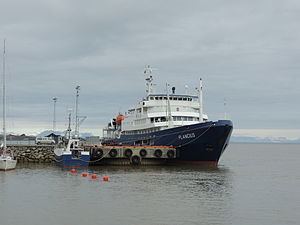Name HNLMS Tydeman (A906) Launched 18 December 1975 Out of service 3 June 2004 Weight 3,175 tons Displacement 3.175 million kg | Laid down 29 April 1975 In service 10 November 1976 Length 90 m Draft 4.7 m Beam 14 m | |
 | ||
Namesake Gustaaf Frederik Tydeman | ||
MV Plancius, formerly HNLMS Tydeman (A906), is a cruise ship that was converted from an oceanographic research vessel of the Royal Netherlands Navy. She was put into service on 10 November 1976 and served until 3 June 2004. Thirty percent of her operational time was used by non-military research institutes and universities. At the time HNLMS Tydeman and the smaller ships HNLMS Buyskes and HNLMS Blommendal formed the so-called white fleet of the Hydrographic Service of the Royal Netherlands Navy. The white fleet was replaced by HNLMS Snellius (A802) from 2003 and HNLMS Luymes (A803) from 2004.
Tydeman was named after Gustaaf Frederik Tydeman, hydrographer of the Siboga Expedition (1899–1900) in the Dutch East Indies. She was the second ship with this name.
The Tydeman fracture zone (36°N 23°W) between Madeira and the Azores is named after Tydeman.
Tydeman was designed for deep sea research worldwide, but in her last years in the navy her tasks were limited to hydrographic surveying in the North Sea and the Baltic Sea. When put out of service, Tydeman was first sold to the Nigerian Navy. However, the Nigerians did not pay.
In January 2007 Oceanwide Expeditions, a tour operator based in Vlissingen, acquired the Tydeman for 900,000 euros. In 2008 the ship was refurbished at the Reimerswaal shipyard in Hansweert. On Saturday 14 November 2009 the Tydeman was renamed MV Plancius after Petrus Plancius (1552–1622), a Dutch cartographer. Plancius, sailing under Dutch flag, is used for cruises to Antarctic and Arctic waters. In May 2011 the ship was back in Hansweert for two weeks of maintenance.
The Plancius can accommodate 116 passengers in 53 cabins. She has a total crew of 45:
